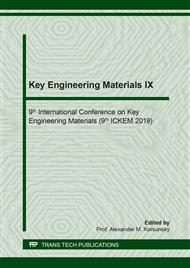[1]
Culebras, Mario, Clara Gómez, and Andrés Cantarero. Review on polymers for thermoelectric applications., Materials 7, no. 9 (2014): 6701-6732.
DOI: 10.3390/ma7096701
Google Scholar
[2]
Chen, Guangming, Wei Xu, and Daoben Zhu. Recent advances in organic polymer thermoelectric composites., Journal of Materials Chemistry C 5, no. 18 (2017): 4350-4360.
DOI: 10.1039/c6tc05488a
Google Scholar
[3]
Chen, G., M. S. Dresselhaus, G. Dresselhaus, J-P. Fleurial, and T. Caillat. Recent developments in thermoelectric materials., International Materials Reviews 48, no. 1 (2003): 45-66.
DOI: 10.1179/095066003225010182
Google Scholar
[4]
El-Asfoury, Mohamed S., Mohamed NA Nasr, Koichi Nakamura, and Ahmed Abdel-Moneim. Structural and Thermoelectric Properties of Bi 85 Sb 15 Prepared by Non-equal Channel Angular Extrusion., Journal of Electronic Materials 47, no. 1 (2018): 242-250.
DOI: 10.1007/s11664-017-5755-7
Google Scholar
[5]
Wang, L., Yuchen L., Zimeng Z., Biran W., Jingjing Q., David H., and Shiren W. Polymer composites-based thermoelectric materials and devices., Composites Part B: Engineering 122 (2017): 145-155.
DOI: 10.1016/j.compositesb.2017.04.019
Google Scholar
[6]
El-Asfoury, Mohamed S., Mohamed NA Nasr, Koichi Nakamura, and Ahmed Abdel-Moneim. Enhanced thermoelectric performance of Bi85Sb15-graphene composite by modulation carrier transport and density of state effective mass., Journal of Alloys and Compounds 745 (2018): 331-340.
DOI: 10.1016/j.jallcom.2018.02.040
Google Scholar
[7]
Yao, Qin, Lidong Chen, Wenqing Zhang, Shengcong Liufu, and Xihong Chen. Enhanced thermoelectric performance of single-walled carbon nanotubes/polyaniline hybrid nanocomposites., Acs Nano 4, no. 4 (2010): 2445-2451.
DOI: 10.1021/nn1002562
Google Scholar
[8]
Gupta, Ankur, Tamilselvan Sakthivel, and Sudipta Seal. Recent development in 2D materials beyond graphene., Progress in Materials Science 73 (2015): 44-126.
DOI: 10.1016/j.pmatsci.2015.02.002
Google Scholar
[9]
El-Moneim, A. A. Mn–Mo–W-oxide anodes for oxygen evolution during seawater electrolysis for hydrogen production: effect of repeated anodic deposition., international journal of hydrogen energy 36, no. 21 (2011): 13398-13406.
DOI: 10.1016/j.ijhydene.2011.07.100
Google Scholar
[10]
El-Moneim, Ahmed A., Jagadeesh Bhattarai, Zenta Kato, Koichi Izumiya, Naokazu Kumagai, and Koji Hashimoto. Mn-Mo-Sn oxide anodes for oxygen evolution in seawater electrolysis for hydrogen production., ECS Transactions 25, no. 40 (2010): 127-137.
DOI: 10.1149/1.3422589
Google Scholar
[11]
Jiang, F., Jinhua X., Weiqiang Z., Congcong L., Liangying W., Feng Z., Huixuan L., and Jingkun X.. Use of organic solvent-assisted exfoliated MoS 2 for optimizing the thermoelectric performance of flexible PEDOT: PSS thin films., Journal of Materials Chemistry A 4, no. 14 (2016): 5265-5273.
DOI: 10.1039/c6ta00305b
Google Scholar
[12]
Acharya, Udit, Patrycja Bober, Miroslava Trchová, Alexander Zhigunov, Jaroslav Stejskal, and Jiří Pfleger. Synergistic conductivity increase in polypyrrole/molybdenum disulfide composite., Polymer 150 (2018): 130-137.
DOI: 10.1016/j.polymer.2018.07.004
Google Scholar
[13]
Choudhary, Nitin, Md Ashraful Islam, Jung Han Kim, Tae-Jun Ko, Anthony Schropp, Luis Hurtado, Dylan Weitzman, Lei Zhai, and Yeonwoong Jung. Two-dimensional transition metal dichalcogenide hybrid materials for energy applications., Nano Today (2018).
DOI: 10.1016/j.nantod.2018.02.007
Google Scholar
[14]
Sajedi-Moghaddam, Ali, Esmaiel Saievar-Iranizad, and Martin Pumera. Two-dimensional transition metal dichalcogenide/conducting polymer composites: synthesis and applications., Nanoscale 9, no. 24 (2017): 8052-8065.
DOI: 10.1039/c7nr02022h
Google Scholar
[15]
Lu, Yutao, Xiayin Yao, Jingyun Yin, Gang Peng, Ping Cui, and Xiaoxiong Xu. MoS 2 nanoflowers consisting of nanosheets with a controllable interlayer distance as high-performance lithium ion battery anodes., RSC Advances 5, no. 11 (2015): 7938-7943.
DOI: 10.1039/c4ra14026e
Google Scholar
[16]
Gomes, E. C., and M. A. S. Oliveira. Chemical polymerization of aniline in hydrochloric acid (HCl) and formic acid (HCOOH) media. Differences between the two synthesized polyanilines., Am. J. Polym. Sci 2, no. 2 (2012): 5-13.
DOI: 10.5923/j.ajps.20120202.02
Google Scholar
[17]
Fedorova, Svetlana, and Jaroslav Stejskal. Surface and precipitation polymerization of aniline., Langmuir 18, no. 14 (2002): 5630-5632.
DOI: 10.1021/la025665o
Google Scholar
[18]
Mombrú, Dominique, Mariano Romero, Ricardo Faccio, and Alvaro W. Mombrú. Polyaniline intercalated with MoS 2 nanosheets: structural, electric and thermoelectric properties., Journal of Materials Science: Materials in Electronics 29, no. 20 (2018): 17445-17453.
DOI: 10.1007/s10854-018-9844-z
Google Scholar
[19]
Gopalakrishnan, Deepesh, Dijo Damien, and Manikoth M. Shaijumon. MoS2 quantum dot-interspersed exfoliated MoS2 nanosheets., ACS nano 8, no. 5 (2014): 5297-5303.
DOI: 10.1021/nn501479e
Google Scholar
[20]
Nguyen, Emily P., Benjamin J. Carey, Torben Daeneke, Jian Zhen Ou, Kay Latham, Serge Zhuiykov, and Kourosh Kalantar-zadeh. Investigation of two-solvent grinding-assisted liquid phase exfoliation of layered MoS2., Chemistry of Materials 27, no. 1 (2014): 53-59.
DOI: 10.1021/cm502915f
Google Scholar
[21]
Mitra, M., Chiranjit K., Krishanu C., Kajari K., Saibal G., Dipali B., and Shyamaprosad G. Reduced graphene oxide-polyaniline composites—synthesis, characterization and optimization for thermoelectric applications., RSC Advances 5, no. 39 (2015): 31039-31048.
DOI: 10.1039/c5ra01794g
Google Scholar
[22]
Shi, Hui, Congcong Liu, Jingkun Xu, Haijun Song, Baoyang Lu, Fengxing Jiang, Weiqiang Zhou, Ge Zhang, and Qinglin Jiang. Facile fabrication of PEDOT: PSS/polythiophenes bilayered nanofilms on pure organic electrodes and their thermoelectric performance., ACS applied materials & interfaces 5, no. 24 (2013): 12811-12819.
DOI: 10.1021/am404183v
Google Scholar


